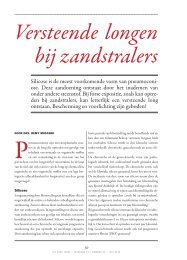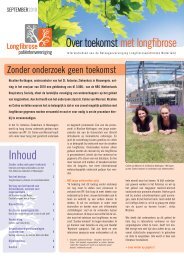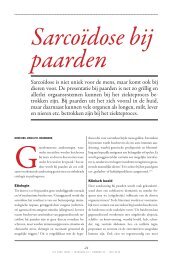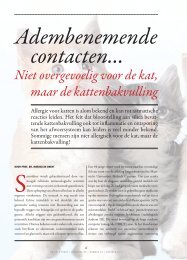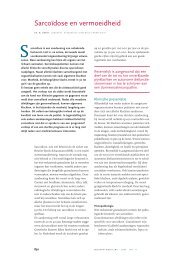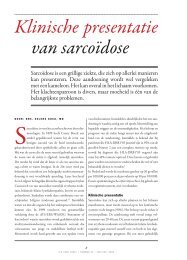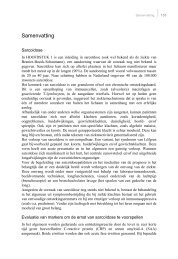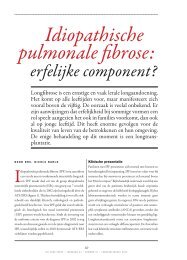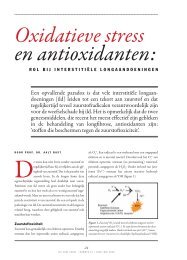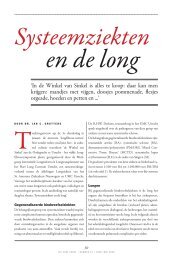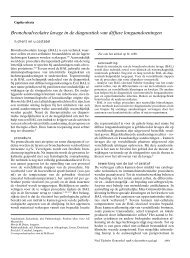Interpretation of bronchoalveolar lavage fluid cytology - ILD care
Interpretation of bronchoalveolar lavage fluid cytology - ILD care
Interpretation of bronchoalveolar lavage fluid cytology - ILD care
You also want an ePaper? Increase the reach of your titles
YUMPU automatically turns print PDFs into web optimized ePapers that Google loves.
Normal alveolar macrophages and respiratory lymphocytes<br />
<strong>Interpretation</strong> <strong>of</strong> BALF <strong>cytology</strong><br />
Following <strong>lavage</strong> recovery <strong>of</strong> rabbit macrophages [24] for in vitro study, research interest peaked to obtain human<br />
lung cells initially from normal volunteer participants through a variety <strong>of</strong> endobronchially placed catheters<br />
(reviewed Ref. 1) and then with fiberoptic bronchoscopy [25,26]. Among the population <strong>of</strong> respiratory cells from<br />
normal young non-smokers, most <strong>of</strong> the cells were alveolar macrophages but about 15% were lymphocytes plus a<br />
few PMNs or other inflammatory cells [21]. Considerable interest was focused on the AM as a phagocytic cell, and<br />
we too were eager to study its immune receptors [27] and antibody-mediated uptake <strong>of</strong> opsonized bacteria [28].<br />
Alveolar macrophages seemed to exist in various sizes as recovered in normal BAL, suggesting subpopulations <strong>of</strong><br />
them with perhaps different functions or representing various stages <strong>of</strong> development [29,30]. The intent was to find<br />
ways to manipulate lung humoral immune responses that might improve the efficiency <strong>of</strong> host defenses to cope<br />
with microbes entering the lower respiratory tract.<br />
Overlooked were a very small population <strong>of</strong> other macrophages now identified as dendritic cells (also Langerhans’<br />
cells) [31], the more efficient antigen presenting cell so effective in initiating cellular immune responses in the lung<br />
[32-34] or increased by smoking [35,36] and associated with certain diseases [37-39].<br />
Others [4,40-42] were attracted to the lymphoid cells initially, and information obtained about cellular immunity<br />
stimulated by lymphocytes became important in many diseases such as sarcoidosis, hypersensitivity<br />
pneumonitis, occupational diseases and respiratory infections such as HIV.<br />
Sarcoidosis: adherence <strong>of</strong> lymphocytes to alveolar macrophages<br />
In a fresh wet mount BAL cell preparation, viewed under phase contrast microscopy, from a patient with active<br />
sarcoidosis [3], the appearance <strong>of</strong> lymphocytes stuck to the surface <strong>of</strong> AMs is striking; the cells adhere and do not<br />
fall <strong>of</strong>f and are not phagocytosed by the AM. A cytospin stained cell preparation makes these rosettes easy to<br />
notice. Occasionally, a spontaneous rosette can be found among BAL cells from a normal smoker or non-smoker,<br />
and YEAGER and colleagues [43] found that 1.8-2.1% <strong>of</strong> AM had one or more adherent lymphocytes. In their group <strong>of</strong><br />
14 sarcoidosis patients, macrophage rosettes involved 8-11% <strong>of</strong> the AMs. We found 4 <strong>of</strong> 17 BAL specimens from<br />
sarcoidosis patients had lymphocyte-macrophage rosettes [44]. The implication <strong>of</strong> these rosettes is still<br />
spectulative, but HUNNINGHAKE and colleagues [5, 45,46] found that the lymphocytosis in BALF from many patients<br />
with sarcoidosis was comprised mainly T-cells which were activated. T-cells were important in creating the<br />
alveolits that probably proceeded granuloma formation. Lung T-cells release a pertinent cytokine in the cellular<br />
activation mechanism(s) <strong>of</strong> sarcoidosis [47]. Certainly, T-cell immune mechanisms have become the research<br />
focus <strong>of</strong> many investigators.<br />
Lung cells in hypersensitivity pneumonitis<br />
This has seemed to be the perfect respiratory disease to study with distinct episodic clinical features, <strong>of</strong>ten a<br />
defined antigen that stimulates specific humoral responses (precipitating antibodies), striking parenchymal lung<br />
involvement that is at first acute but can become chronic and persist (<strong>of</strong>ten establishing host tolerance when<br />
repeated antigen exposure continues), and decidedly immunologic in nature (but not allergic) [48-50]. Performing<br />
BAL analysis on the first patients we encountered [22] was fascinating - all the ingredients were present in BALF<br />
between the alveolar cells and the <strong>lavage</strong> supernatant <strong>fluid</strong> (and contrasted with the patient’s serum) to fit the<br />
immunologic response together.<br />
The patient’s clinical history usually gave good clues to the kind <strong>of</strong> antigen(s) encountered in his/her environment<br />
or workplace. A specific precipitating antigen-antibody reaction could be found in serum and occasionally in BAL<br />
<strong>fluid</strong> (for 3 <strong>of</strong> the initial 7 patients studied [23]), which was in the IgG fraction in BALF. Although IgM levels were<br />
detected in BALF, no precipitating antibody activity was found. IgE and two complement components, C 4 and C 6,<br />
were in normal amounts in BALF. The other surprise was the composition <strong>of</strong> the BAL cells. Lymphocytes<br />
predominated in the cellular count, a mean count <strong>of</strong> about 62%, and the majority were T-lymphocytes (mean 70%),<br />
and about 6% were B-cells (assayed with sheep erythrocyte forming rosettes). Alveolar macrophages, reciprocally<br />
reduced in proportion to the high percentage <strong>of</strong> lymphocytes, were about 29% <strong>of</strong> the total <strong>lavage</strong> recovered cells.<br />
Within the macrophage population, larger than usual size macrophages were seen with vaculolated and opaque<br />
appearing cytoplasm and few granules; these were considered ‘foamy’ or engorged macrophages [51].<br />
History. H.Y. Reynolds. 2001. 2



